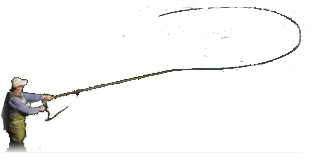FELT OR NO FELT - Neil - January 24, 2011
FELT OR NO FELT
If you currently use felt-soled waders or wading boots it?s likely that you will need to replace them sooner rather than later. Currently the State of Alaska has banned the use of felt-soled wading gear in all fresh water streams. Several other states currently are considering a similar ban. [My research indicates that, in addition to Alaska, Vermont and Maryland have banned felt-soled wading gear, and Oregon and Montana have similar proposals in the legislative hopper]
Didymo and Mud Snails......
I do not use felt boots, even though I bought some for the 2003 Idaho Fish-In. Most of the time when I go fishing I do not tramp through the water. I either fish from shore, or I get into my WaterSkeeter Poontube and kick-paddle around with my fins fins. After fishing I hand my poontube outside to dry, as for my swimming fins. it is gotten to a point that I have separate fly boxes, one for each body of water that I fish. All my fly rod gear gets cleaned after each outing and air dried. Sometimes I will not use a fly rod or other gear of two separate water if the time span between when I fish the two separated water is under two week.
I never heard about "didymo" (Didymosphenia geminata), until I read this weeks article. After reading your article I did a quick web search is found a listing of regions in North America that "didymo" has already been found. British Columbia, Alberta, South Dakota, Tennessee, Vermont, New Hampshire, New York, and Maryland. Hot spots that have it, with out knowing how it got there, but rest assured that someone unaware of this problem, will be the carrier to transport it to a new region.....
http://en.wikipedia.org/wiki/Didymos...a#Native_range
As for the "New Zealand Mud Snails" (Potamopygus antipodarum), I asked that question to FAOL's "Stream Doctor" many years ago (for some reason I cannot find his articles at the moment). As the the Stream Doctor stated in his reply article to my question, that the New Zealand Mud Snails" came to either Washington or Oregon State Trout Hatcheries, from a shipment of trout from New Zealand. Not knowing that that these trout were carrying the Mud Snails in their intestines, the snails found a new home in Idaho, when some of these trout were some how released. The "Stream Doctor" explained, that the "New Zealand Mud Snail" has a natural predator in New Zealand to keep down their population. There is no such predator for the "New Zealand Mud Snail" in North America. Similar to the case with the Zebra Mussels. Anyway, the "New Zealand Mud Snail" is what in common terms is classified as a "Trapdoor Snail". Meaning that if consumed by a fish, the snail has trapdoors at both ends of the snail digestive track, which close so the fish's digestive track can gain any nourishment from the snail, and the snail can survive inside the fish for up to two weeks before it exits at the other end of the fish. Same applies if the "New Zealand Mud Snail" somehow get into your fishing gear, drift boat or Poontube. The "New Zealand Mud Snail, can survive up to two weeks out of water. Because of their very effective way of surviving, they soon take over any stream where there is no predator to control their numbers. Uncontrolled they can take over a trout stream with as many as a 1000 mud snails per square of stream bottom. The trout in the stream will perish from the lack of malnutrition.
http://en.wikipedia.org/wiki/New_Zealand_mud_snail
The list of plants and living life forms that have found new homes in North America is staggering....
http://www.invasivespeciesinfo.gov/r...es/lists.shtml
In Minnesota we are fighting battles against the following Aquatic Aniamal...
Bighead Carp, Silver Carp and Grass Carp
Faucet Snails
NZ Mud Snails
Zebra Mussels
Round Goby (fish)
Ruffe (fish)
Rusty Crayfish
Lamprey Eel
Spiny Water Flea
White Perch
Chinese Snail
Banded Snail
just to name a few the aquatic animals, there are also other lists for aquatic vegetation
http://www.dnr.state.mn.us/invasives...als/index.html
~Parnelli
